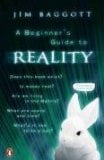 Beginner’s Guide to Reality
Beginner’s Guide to Reality
by Jim Baggott
Penguin Books, £7.99, ISBN 0-141-01930-1
Although the author does not use the word, this is an introduction to epistemology, the study of how we know, and how we can know that we know. Can we, in fact, be sure that anything is real? Three major problems are logical, psychological and physical.
The logical problem is, how can we be sure of reality unless we have some reality to test it against? Descartes proposed the most famous answer, that he was sure he existed because he was asking the question: cogito, ergo sum. But philosophers have since rejected this. The psychological problem is, that everything we ‘know’ is processed by the brain and nervous system. Not only are these fallible, we have no direct apprehension of what they represent. The physical problem is, that modern physics seems to show that at a basic level, the universe is in principle unmeasurable, that is unknowable. Baggott discusses all these, though he starts, as I think rather misleadingly, with social reality, arguing that it only exists as long as we believe it to exist. For example, money is only money as long as we believe in it. I think it is accepted as simply a means of exchange. ‘Belief ’ has nothing to do with it. The final chapter summarises the arguments, and some might like to read this first.
There is another approach to the problem, a religious one that claims direct apprehension of reality. Personally I don’t accept this, but it deserves discussion. The style is chatty and informal, with lots of references to fantasy and science fiction. Some will find it amusing and illuminating, others merely facetious and tiresome; it really is a matter of taste. The wording is sometimes imprecise, for example ‘purpose’ and ‘function’ seem to be equated, and ‘belief ’ is used in various senses, but overall it is a very readable introduction.
John Radford

